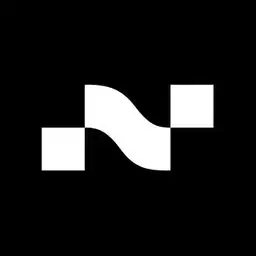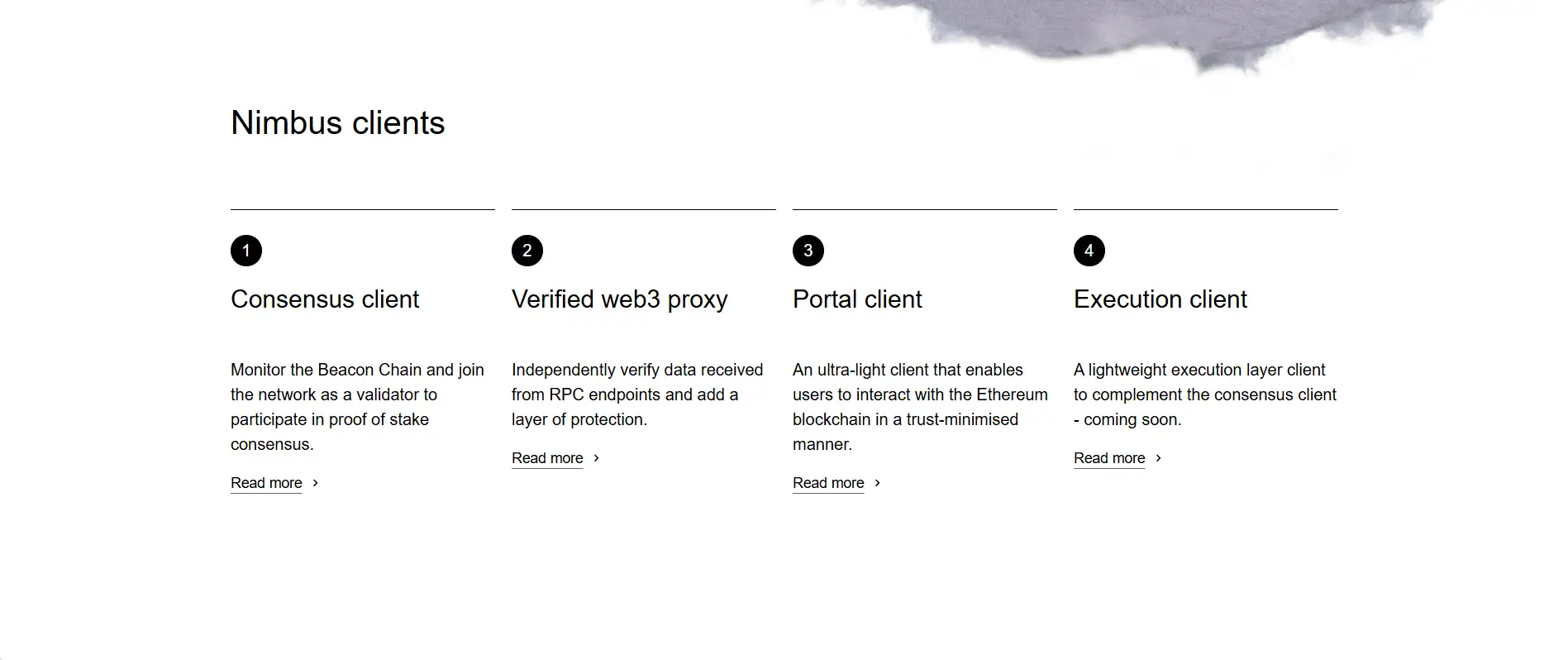About Nimbus
Nimbus is a lightweight and high-performance Ethereum client designed to make blockchain participation more accessible and decentralized. Developed by the team behind Nimbus, the project aims to serve a broad spectrum of users—from solo stakers using Raspberry Pi devices to enterprise-level node operators looking for resource-optimized solutions. Its low CPU and memory footprint makes it ideal for users who want resilient Ethereum infrastructure with minimal overhead.
The project operates under the ethos of building Ethereum infrastructure that’s truly inclusive. Nimbus supports client diversity and network decentralization by offering consensus clients, verified Web3 proxies, portal clients, and execution clients (coming soon). With active development since 2018 and support from both the Ethereum Foundation and Status, Nimbus is a key player in building the next-generation Ethereum ecosystem for everyone.
Nimbus was created with a vision to bridge the gap between Ethereum’s robust infrastructure and the devices that most people have access to. Originally announced in 2018 by Status, Nimbus started as a research-driven initiative focused on making Ethereum clients work seamlessly on low-spec hardware like Raspberry Pis and mobile phones. The idea was to support Ethereum decentralization not only in principle but in actual deployment—moving away from reliance on high-powered servers to making blockchain access available from nearly anywhere.
Over the years, Nimbus has matured into a full-scale production-level project with several modules, including a consensus client, a verified Web3 proxy, and a portal client. Its consensus client handles both Beacon Node and validator client functionalities, making it easier for validators to run nodes efficiently. The verified Web3 proxy allows decentralized apps to validate RPC data independently, enhancing both trustlessness and data integrity. The portal client provides a truly lightweight method for users to interact with Ethereum without depending on centralized RPC services.
In contrast to older Ethereum clients like Geth, Nethermind, and Hyperledger Besu—which are optimized for performance on powerful machines—Nimbus addresses a specific need in the Ethereum landscape: client diversity for minimal-resource environments. This is not only beneficial for decentralization but also critical during network congestion or failovers, as Nimbus offers better redundancy through multi-client connections.
Security is another cornerstone of Nimbus. The software has been audited by renowned firms such as ConsenSys Diligence, Trail of Bits, and NCC Group. Its resilient architecture allows validators to connect to multiple execution layer clients simultaneously, increasing uptime and reducing single points of failure. Independent reports like those by MigaLabs confirm that Nimbus excels in CPU and memory efficiency, especially after major Ethereum upgrades like Dencun.
As part of the Status ecosystem, Nimbus is also aligned with broader goals like integrating into mobile-first decentralized applications and privacy-respecting tools. Its open-source licensing and commitment to public good funding ensures that Nimbus remains accessible, transparent, and community-driven.
Nimbus provides a suite of benefits and features that make it a cornerstone project for Ethereum client diversity and decentralized infrastructure:
- Lightweight Performance: Nimbus clients are optimized for low memory and CPU usage, allowing them to run on Raspberry Pis, mobile devices, and other low-resource systems without compromising reliability.
- Modular Architecture: Whether you need a Beacon Node, a validator client, or a Web3 proxy, Nimbus lets you run each component independently or as a combined package.
- Resilient Validator Setup: Connect your validator client to multiple Beacon Nodes and execution clients simultaneously to ensure uptime and reduce failure risks during high-load conditions.
- Enhanced Security: Audited by firms like ConsenSys Diligence and Trail of Bits, Nimbus provides robust slashing protection and doppelganger detection mechanisms.
- Onchain Data Verification: The verified Web3 proxy enables decentralized apps to validate data independently, reducing reliance on third-party RPCs and enhancing trustlessness.
- Community-Driven: Backed by Status and the Ethereum Foundation, Nimbus is built as a public good with liberal open-source licensing.
Nimbus makes it simple for users—whether solo stakers or enterprise operators—to get started with their Ethereum client suite:
- Visit the Guide: Go to the official Nimbus Guide for full documentation, downloads, and setup instructions.
- Quick Start: Set up a Beacon Node with built-in validator duties using the Quick-Start Guide. This is ideal for users seeking simplicity and speed.
- Advanced Setup: If you prefer using an alternative validator or Beacon Node, Nimbus supports modular configurations. Use their setup guides for Beacon Nodes or Validators independently.
- Run Light Clients: For minimal setups, you can run the Portal Client to connect to Ethereum in a trust-minimized way without a full Beacon Node.
- Integrate with Status: If you're using the Status App, future updates will enable direct validator monitoring and integration with Nimbus clients.
- Join the Community: Get support or contribute by joining the Nimbus Discord or visiting the official site.
Nimbus FAQ
Client diversity is essential for maintaining a secure and censorship-resistant Ethereum network. When too many validators rely on the same client software, bugs or vulnerabilities in that client can lead to major network disruptions. Nimbus strengthens Ethereum by offering a lightweight alternative to mainstream clients like Geth or Prysm. It helps reduce centralization risk and encourages a healthier distribution across consensus clients, especially among solo stakers and small node operators.
Yes. Nimbus was specifically designed to run efficiently on low-resource devices like Raspberry Pi and mobile hardware. Its lightweight architecture uses minimal CPU and memory, making it ideal for users who want to participate in Ethereum’s network without enterprise-grade infrastructure. This makes Nimbus especially attractive for solo stakers looking to contribute to decentralization.
Nimbus allows validators to connect to multiple Beacon Nodes and execution layer clients simultaneously. This redundancy ensures uptime even if one node or client fails, which is crucial during periods of high network load. As highlighted in studies like MigaLabs’ hardware report, Nimbus consumes fewer resources, leaving more headroom to handle stress without crashing or lagging.
The verified Web3 proxy in Nimbus acts as a security layer for decentralized applications. It allows clients to independently verify the data received from RPC endpoints, rather than blindly trusting third-party infrastructure. This helps dApps reduce their reliance on centralized RPC providers and protects users from data manipulation or downtime. It's a critical step toward more trust-minimized and self-sufficient web3 applications.
Nimbus is developed as a public good and relies on funding from organizations like the Ethereum Foundation and Status. It also accepts donations from the community. This open funding model ensures that Nimbus remains free, open-source, and free from corporate control. The focus stays on decentralization and community needs, not profit-driven incentives.
You Might Also Like












